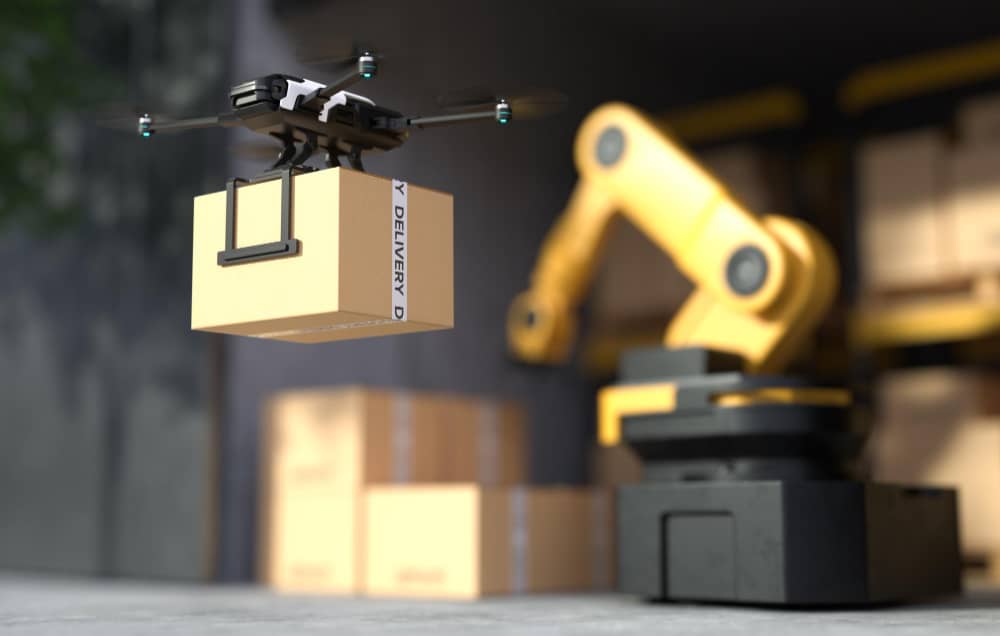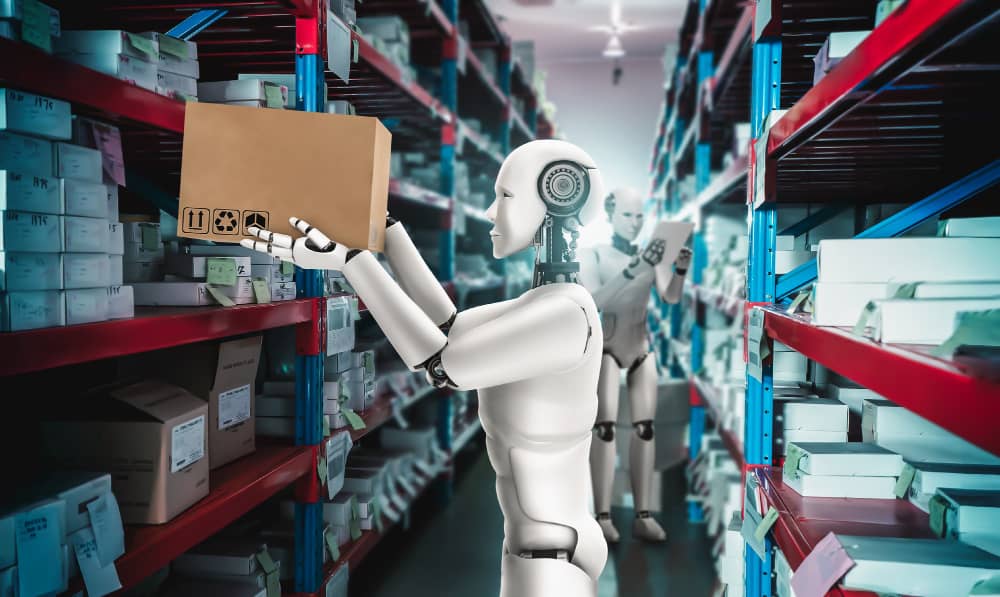The emergence of Artificial Intelligence (AI) is opening an entirely new chapter for the Print on Demand (POD) industry, where speed, accuracy, and customer experience have become the core standards of competition. In the past, sellers struggled with slow fulfillment processes, production errors, high operating costs, and inconsistent service quality. But today, AI is transforming the entire game. This article will explore how AI is reshaping the future of fulfillment, delivering comprehensive solutions that accelerate speed, reduce costs, optimize the seller experience, and usher in a new era of intelligent global operations.

Fulfillment in POD: From Automation to Artificial Intelligence
It’s important to clarify one thing: Automation and Artificial Intelligence (AI) are not the same.
Between 2018 and 2022, most major POD printing facilities around the world focused on automating their production lines integrating printers, packaging systems, tracking code generation, and automated order updates. This was a major leap forward that eliminated many manual tasks. However, this model remained essentially reactive it only executed pre-programmed commands without the ability to “think” or adapt.
The limitations of this “reactive” model become painfully clear when order volumes surge. During holiday seasons (Q4) or flash sale campaigns, automated systems are unable to dynamically allocate resources. They can’t “reason” to rebalance workloads, leading to severe backlogs, production errors, and delayed deliveries the ultimate nightmares for any POD seller.
That’s where AI steps in to completely change the game.
AI transforms fulfillment from simple automation to an adaptive system. Instead of waiting for human intervention during crises, an AI-powered fulfillment network can:
- Analyze order trends and volumes in real time.
- Automatically assign orders to the most suitable printing lines and machines based on current capacity and service-level agreements (SLA).
- Predict potential risks such as fabric shortages, printer overloads, or SKU mismatches, and issue early warnings before problems occur.
In other words, with AI, fulfillment evolves from a passive order processor into an intelligent decision-making system, one that actively ensures smooth operations even when your store is facing a massive order storm.
5 Practical Applications of AI in POD Fulfillment

AI is not a magic wand it’s a powerful toolkit designed to solve specific problems. Below are five ways AI is completely transforming the landscape of leading fulfillment centers in the Print on Demand industry.
Demand Forecasting and Smart Inventory Preparation
One of the biggest pain points for POD sellers is running out of blanks (out-of-stock) right in the middle of a major sales season. AI solves this problem through predictive analytics, the ability to forecast demand based on massive datasets.
An AI system can “learn” from a wide range of data: your sales history, seasonal patterns, upcoming events, and even end-customer behavior in the market. From these insights, it generates accurate forecasts for production needs.
Real-world example: FlashShip’s system can analyze and identify that from October to December, hoodie orders (Gildan 18500) in Texas, USA typically spike by 60% due to colder weather. Based on this prediction, the system automatically sends alerts to restock hoodie blanks and matching ink types at least two weeks in advance.
This brings three direct benefits to sellers:
- Minimizes the risk of running out of blanks during the Q4 peak season.
- Optimizes warehouse space and inventory turnover, reducing unnecessary storage costs.
- Shortens production time since materials are always available, ensuring on-time delivery (SLA compliance).
Automated Production Optimization

In a traditional print shop, assigning orders to production lines is often done manually leading to some machines being idle while others are overloaded. AI changes that by acting as a smart “conductor” that harmonizes the entire operation.
The AI system continuously monitors each printer’s real-time status, shift productivity, and backlog levels to automatically allocate jobs in the most efficient way.
For example:
- Detecting that Line 1 is idle and specializes in light-colored garments → AI automatically assigns the next 50 white shirt orders to this line.
- Recognizing that Line 2 handles dark apparel (requiring white underbase) and is about to complete its current batch → AI queues 30 black shirt orders next in line.
As a result, the entire production system operates like a living organism, flexible, waste-free, and consistently performing at its highest efficiency.
Quality Control with Computer Vision (AI Vision)
A one-star review caused by printing errors wrong colors, misaligned designs, or fabric wrinkles is every POD seller’s nightmare. Manual quality checks (QC) take time, depend heavily on human attention, and often miss subtle mistakes.
AI Vision (Computer Vision) is the solution to this problem. High-resolution cameras are installed directly at each printing station or at the final QC checkpoint. As each product passes through, the AI system will:
- Capture an image of the actual printed product.
- Instantly compare it with the seller’s original mockup file.
- Detect and highlight defects (such as 1cm misalignment, incorrect color code, or stains) within 0.5 seconds.
- Send alerts to the system and automatically remove defective items before they are packaged.
This technology helps reduce up to 70% of defective orders reaching customers, protecting brand reputation and saving sellers thousands of dollars in refund or resend costs each month.
Smart Logistics and Delivery Route Optimization
After printing, the logistics phase is often the most expensive and risk-prone step. AI plays a crucial role in optimizing this “last-mile delivery” process.
Instead of merely choosing the cheapest carrier, AI analyzes multiple variables such as:
- Delivery location (urban vs. remote area).
- Weather and traffic conditions in the delivery region.
- Real-time shipping rates and carrier performance (USPS, UPS, FedEx, DHL, etc.).
From these factors, AI automatically selects the most optimal delivery route, balancing cost and speed, while predicting a more accurate Estimated Time of Arrival (ETA) than human planners.
As a result, POD sellers can cut logistics costs by 10–20% and significantly reduce issues like “stuck tracking” during peak seasons, ensuring a smoother and more reliable delivery experience for customers.
Automated Customer Service (AI Customer Support)

POD sellers often spend excessive time answering repetitive questions, especially the classic “Where Is My Order?” (WISMO) inquiries. AI chatbots and automated support systems are now freeing sellers from this burden by handling such interactions instantly and accurately.
Modern AI chatbots are directly integrated with fulfillment systems and carrier APIs, allowing them to access real-time order data and respond automatically.
Example 1: When a customer asks, “Where’s my order #12345?” → The AI chatbot automatically retrieves the tracking information and replies: “Your order is currently at the USPS transit hub in Dallas and is expected to be delivered on November 5.”
Example 2: When a customer requests a size exchange (due to their own mistake) → The AI can automatically generate and send a link for a self-service return/exchange process, without any seller intervention.
This technology helps reduce response time by up to 50%, providing a faster, more professional experience for both sellers and end customers, a critical factor in building trust and long-term loyalty in the POD industry.
The Critical Benefits of AI for POD Sellers
Implementing AI in fulfillment is not just a factory “upgrade”, it’s a strategic weapon that delivers direct and vital advantages for every POD seller. When your fulfillment partner operates with AI, here’s what you gain:
Save Time – Maximize Fulfillment Speed to the Extreme
In the world of e-commerce, speed is king. AI eliminates all “dead time” (latency) caused by manual operations. The moment a customer clicks “Buy”, the AI-driven system has already:
- Processed the order instantly, no human confirmation required.
- Automatically assigned the job to the optimal printing line and placed it in the production queue within seconds.
- Updated tracking information in real time as soon as the order is packaged.
With a fully AI-integrated fulfillment system, up to 90% of orders can be completed and shipped within just one business day. This is a massive competitive advantage when you’re competing against other sellers and serving U.S. customers who are already accustomed to Amazon Prime level speed.
Reducing Operating Costs and Maximizing Profitability
Speed means nothing if high costs eat away your profit margins. AI directly impacts your bottom line by eliminating inefficiencies and reducing waste. Through intelligent forecasting and smart resource allocation, sellers can save costs across multiple stages:
- Fewer errors (thanks to AI Vision) significantly lower refund and resend rates.
- Reduced material waste, as AI accurately predicts blank and ink requirements — minimizing excess inventory and unnecessary consumption.
- Optimized labor and machine utilization help cut overtime expenses and prevent resource overuse.
According to a 2025 eFulfillment Service survey, the application of AI can help POD businesses reduce total operational costs by up to 25%. That reduction directly affects your base cost and net profit per product sold, giving you greater pricing flexibility and higher margins.
Enhancing Accuracy and Ensuring Consistent Print Quality

For POD sellers, 5-star reviews are the lifeblood of the business and inconsistent print quality is the ultimate brand killer. AI Vision combined with Machine Learning acts as a 24/7 guardian of your brand by:
- Ensuring color consistency across different production batches.
- Automatically aligning print positions, keeping your design perfectly placed every time.
- Detecting and eliminating defects before packaging.
With AI, sellers not only achieve faster fulfillment but also maintain flawless quality consistency, the key factor in building customer trust and long-term brand loyalty.
Unlimited Scalability for Business Growth
In the past, hitting 10,000 orders per day during Q4 was every POD seller’s nightmare. You had to deal with massive backlogs, or your fulfillment partner had to open new facilities and hire hundreds of workers, disrupting the entire operation.
Today, AI enables a twofold or even threefold increase in productivity without the need for proportional manpower expansion. The more orders the AI system processes, the more it “learns” and the more accurate it becomes. Fulfillment evolves into a form of symbiotic intelligence a seamless collaboration between machines and data.
This allows sellers to scale their business at lightning speed while maintaining consistent output quality and operational stability.
Elevating the Customer Experience
Ultimately, all these benefits lead to one core goal: enhancing the end-customer experience. Speed, accuracy, and transparency are the three pillars that drive customer loyalty.
AI ensures that your customers:
- Receive the right product, on time, every time.
- Have clear, real-time tracking updates throughout the shipping process.
- Get instant responses from AI chatbots, instead of waiting days for support replies.
When buyers are satisfied, sellers can boost their repeat purchase rate by 30–40%, a remarkable achievement and the true key to long-term sustainability in the POD industry.
Challenges and Limitations of Applying AI in Fulfillment

While AI offers countless benefits, its implementation is far from simple. Both POD sellers and fulfillment providers must understand the real-world challenges and limitations in order to leverage this technology effectively.
Data and Initial Implementation Costs
AI is “intelligent” because it is fueled by data. For an AI system to operate effectively, it requires a massive amount of clean, structured, and high-quality data across every aspect of the business, from order history and production workflows to logistics metrics and customer behavior.
This creates a significant barrier. Many small sellers or new print facilities lack standardized data, making it difficult for AI systems to “learn” accurately and generate reliable predictions.
Moreover, the initial integration cost can be substantial. Equipping facilities with AI Vision cameras, investing in software, building machine learning frameworks, and hiring data engineers require investments that can reach millions of dollars.
This is why only large-scale fulfillment centers with long-term strategic vision and financial capacity can fully implement AI in a systematic, sustainable way.
AI Reliability in Edge Cases
AI performs exceptionally well with repetitive tasks and standardized data. However, it can become “confused” or make incorrect decisions when encountering edge cases, unusual situations it was never trained to handle.
For example:
- Complex design patterns: A design intentionally using a distressed or vintage texture might be misinterpreted by AI Vision as a printing defect and automatically rejected.
- Uncommon operational errors: A duplicated order ID caused by a platform glitch could lead AI to assign the wrong production line, resulting in duplicate prints.
That’s why the human element remains irreplaceable. A skilled human supervision team is still required to immediately intervene when AI “thinks wrong” and to manage complex situations that machines cannot yet fully understand.
Data Security and Privacy
This is one of the biggest concerns for POD sellers. When you upload your design files (your intellectual property) and share customer information (names, addresses) with a fulfillment partner, you are placing significant trust in their systems.
As AI processes millions of designs and personal data records, the risk of data breaches becomes substantial if the infrastructure is not properly encrypted and protected. Even a single vulnerability could result in design theft or customer information leaks, potentially violating data protection laws such as GDPR.
Therefore, sellers must choose reputable fulfillment partners that adhere to internationally recognized data security standards, such as ISO 27001 or equivalent certifications, to ensure their assets remain safe and secure.
Skill Gaps and Workforce Training
Equipping a fulfillment center with AI is one thing, knowing how to use it effectively is another. AI is not a “magic wand”; it requires the operations team to develop new technical and analytical skills.
They must know how to:
- Read and interpret analytics dashboards and understand the insights AI provides.
- Configure rules, triggers, and automated behaviors so that AI performs according to the intended logic.
Without a structured training and onboarding roadmap, the AI system can easily become “a complex machine no one knows how to use” instead of the intelligent assistant it’s meant to be.
Risk of Overdependence on Technology
When an entire production system from A to Z, is governed by AI, the risk of technological dependency becomes real. Imagine if the central AI server experiences a malfunction or downtime in the middle of Black Friday the entire production line could come to a complete halt.
For this reason, professional fulfillment centers always maintain a backup or hybrid mode. They keep manual or semi-automated contingency workflows ready to activate instantly, ensuring orders continue to be processed smoothly and minimizing the risk of disruption for sellers.
In an era where speed and technology define success, choosing the right Fulfillment partner is the key for POD sellers to break through and scale.
With a U.S.-standard operational system and the comprehensive application of AI across its Fulfillment process, FlashShip helps you process orders faster and more accurately while optimizing costs, enhancing customer experience, and enabling sustainable business growth.
If you’re looking for a smart, fast, and reliable Fulfillment partner, contact FlashShip today via hotline (+84) 943 024 337 or visit seller.FlashShip.net to receive detailed consultation and begin your journey to Fulfill with intelligence – Succeed with speed!

